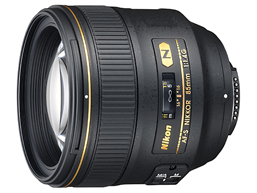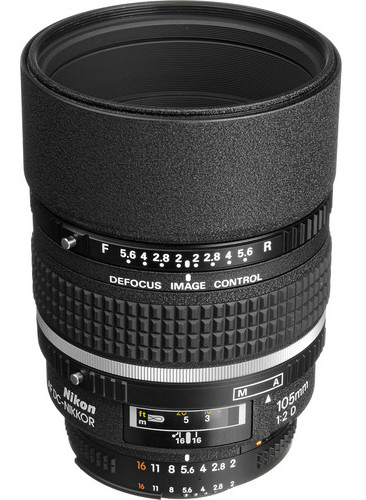Nikkor autofocus portrait lenses
Many lenses with a focal length of 80-100 mm. were/are used as portrait lenses as they produce images with a natural perspective and the photographer doesn´t need to creep into a model. Unfortunately these lenses lost their function when the digital reflex cameras with a crop factor of 1.5 were introduced. Mounted on a Nikon D3 however they regain their very nice function. The lenses reviewed below are very well usable on all Nikon SLR cameras for portrait or close-up photography. Especially their relatively fast aperture are very welcome for available light photography. The two fast lenses had manual focus ancestors, both with an indestructible reputation. The auto focus lenses are build after the same qualitative norms and produce very sharp images, even at full open aperture down to 85 cm. To choose the one or the other is simply a matter of budget.
AF-Nikkor 2.8 & 4.5/80 mm. (for Nikon F3-AF)
These two lenses are a bit the odd men out in the entire Nikkor range. Let´s start with the last mentioned lens, the extremely rare prototype AF-Nikkor 4.5/80 mm. This huge (nearly three kilo) lens was shown at the 1971 Phot Expo in Chicago (USA); it was never marketed. It took Nikon probably 12 years to develop a more realistic autofocus lens. The AF-Nikkor 2.8/80 mm. (pictured above) was introduced in April 1983 together with the Nikon F3-AF camera and another AF-Nikkor (3.5/200 mm.). It was a totally new design, thus not a converted existing Nikkor lens. The optical formula consists of 6 elements in 4 groups; it can be focused down to 1 meter and the aperture range is 3.5 - 32. The lens can be used on any Nikon SLR, but auto focus will not work on modern cameras, except the universal Nikon F4 !! For those days it was a revolutionary lens: small, very well usable, relatively fast (0.5 seconds to run through the distance scale), light (390 gram) and razor sharp. It is advised not to use this lens on macro rings or bellows. Nowadays a rare and thus very collectible lens. Serial numbers start at 182011. Hood HS-7 is recommended.
AF-Nikkor 1.8/85 mm. / AF-S Nikkor 1.8/85 mm.G
The manual ancestor of this lens was introduced in 1964. It became a very popular lens among fashion photographers. Through the years it underwent several optical changes. In 1988 the first auto focus version was presented. It has 6 individual elements and uses 62 mm-filters. The second auto focus version was introduced in 1994. Optical design remains unchanged but the lens features the distance data transfer and rear focusing technology. The HN-23 hood comes with the lens.
Early January 2012 Nikon introduced a successor: the AF-S 1.8/85 mm. G. This version has a built-in Silent Wave Motor and (unfortunately) a G-mount, making it impossible to mount this lens on older film cameras. The optical formula was re-designed: 9 individually mounted elements with a 7-blades diaphragm. The lens can be focused down to 80 cm., uses 67 mm. filters and the HB-62 bayonet hood.
AF-Nikkor 1.4/85 mm. / AF-S Nikkor 1.4/85 mm. G This huge, but relatively light (550 gram) lens has a manual focus ancestor as well, which was introduced in 1981. The manual focus version has an optical design of 7 elements in 5 groups, uses 72 mm filters and weights in at 620 gram. The auto focus version is in many ways a redesign as it consists of 9 elements in 8 groups, uses 77 mm filters and is a bit lighter with its 550 gram. The close range correction of the manual focus version is changed into a rear focus system in the auto focus version. This lens may need the HN-31 hood.
In August 2010 a very nice successor was introduced, though with a G-mount: AF-S 1.4/85 mm. This lens has a slightly modified optical design (10 elements in 9 groups) featuring a built-in Silent Wave Motor and Nikon's famous Nano-Crystal coating. This lens, that can be focused down to 85 cm., may use 77 mm. filters and the best hood is HB-55. This beautiful lens weights in at 595 gram.
AF-S 1,4/105 mm.E ED Late July 2016 Nikon introduced this very fast portrait lens for its FX cameras.. It is an 'unique design concept of three-dimensional high fidelity' as stated in Nikon's press release. The heavy (985 gram) lens has an optical formula of 14 elements in 9 groups; 3 elements (no. 2, 3 and 10) are made of ED glass, while some elements are featuring nano crystal coating and fluorite coating. The latter to protect the front and rear lens. The lens has a diaphragm of 9 blades, can be focused down to 1 meter, has - of course - the Silent Wave Motor for fast focusing and a filter thread of 82 mm. The best hood is HB-79. Unfortunately the lens has no aperture indicator, but - and that is quite unique - an electronic aperture.
2/105 mm.
This lens is born as AF-Nikkor 2/105 mm. DC. This very exceptional lens - introduced in September 1993 - is fitted with ´Defocus-image-Control´. Its optical construction of 6 individual elements features the possibility to move some elements in relation to the others. This may result in certain (intentionally) unsharp areas, especially interesting in portrait or product photography. The lens has rear focus technology and D (=distance) data transfer. For studio flash photography an excellent lens. Below you may find its sister with the same features + 20 mm extra focal length.
|





